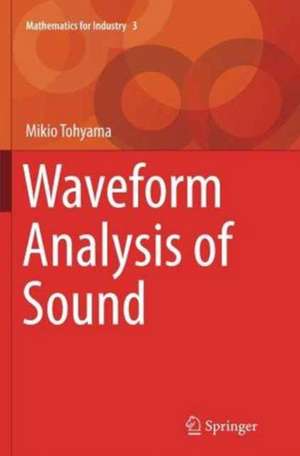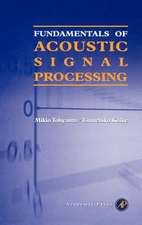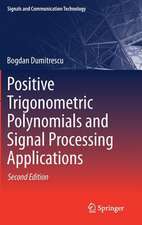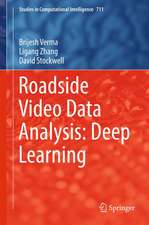Waveform Analysis of Sound: Mathematics for Industry, cartea 3
Autor Mikio Tohyamaen Limba Engleză Paperback – 6 oct 2016
This book is inspired by such processing schemes and is oriented to signature analysis of waveforms. Most of the examples in the book are taken from data of sound and vibrations; however, the methods and theories are mostly formulated using mathematical expressions rather than by acoustical interpretation. This book might therefore be attractive and informative for scientists, engineers, researchers, and graduate students who are interested in the mathematical representation of signals and the applications of Fourier analysis.
The book can be described as being practically self-contained but does assume readers are familiar with introductory topics in discrete signal processing, as in the discrete Fourier transform. Hence this book might be also usable as a textbook in graduate courses in applied mathematics on topics such as complex functions. Almost all scientific phenomena are sensed as waves propagating in some space. Over the years, waveform analysis has therefore been one of the resilient academic areas of study and still is seen as fertile ground for development. In particular, waveform analysis based on the theory of linear systems would be a good example where a physical interpretation can be given to the mathematical theory of complex functions in terms of magnitude, angle, poles, and zeros of complex functions.
For readers who are interested in the physical aspects of sound and vibration data or elementary formulation of wave equations and their solutions, the book Sound and Signals by M. Tohyama (Springer 2011) is recommended. It can serve as a complementary companion to this present volume or independently as a good reference.
| Toate formatele și edițiile | Preț | Express |
|---|---|---|
| Paperback (1) | 556.52 lei 38-44 zile | |
| Springer – 6 oct 2016 | 556.52 lei 38-44 zile | |
| Hardback (1) | 644.30 lei 6-8 săpt. | |
| Springer – 20 ian 2015 | 644.30 lei 6-8 săpt. |
Din seria Mathematics for Industry
- 18%
 Preț: 948.79 lei
Preț: 948.79 lei - 20%
 Preț: 644.66 lei
Preț: 644.66 lei -
 Preț: 401.61 lei
Preț: 401.61 lei - 18%
 Preț: 790.14 lei
Preț: 790.14 lei - 24%
 Preț: 773.71 lei
Preț: 773.71 lei - 5%
 Preț: 1416.66 lei
Preț: 1416.66 lei - 15%
 Preț: 651.19 lei
Preț: 651.19 lei - 20%
 Preț: 567.44 lei
Preț: 567.44 lei - 15%
 Preț: 641.71 lei
Preț: 641.71 lei - 18%
 Preț: 1226.73 lei
Preț: 1226.73 lei - 18%
 Preț: 944.82 lei
Preț: 944.82 lei - 15%
 Preț: 651.34 lei
Preț: 651.34 lei - 15%
 Preț: 646.62 lei
Preț: 646.62 lei - 15%
 Preț: 645.79 lei
Preț: 645.79 lei - 15%
 Preț: 643.65 lei
Preț: 643.65 lei - 18%
 Preț: 944.36 lei
Preț: 944.36 lei - 15%
 Preț: 641.38 lei
Preț: 641.38 lei - 18%
 Preț: 947.85 lei
Preț: 947.85 lei - 15%
 Preț: 643.48 lei
Preț: 643.48 lei - 18%
 Preț: 945.30 lei
Preț: 945.30 lei - 20%
 Preț: 997.38 lei
Preț: 997.38 lei - 15%
 Preț: 644.30 lei
Preț: 644.30 lei - 18%
 Preț: 946.10 lei
Preț: 946.10 lei - 18%
 Preț: 890.06 lei
Preț: 890.06 lei -
 Preț: 354.54 lei
Preț: 354.54 lei - 18%
 Preț: 1212.84 lei
Preț: 1212.84 lei - 18%
 Preț: 1103.14 lei
Preț: 1103.14 lei - 15%
 Preț: 641.85 lei
Preț: 641.85 lei
Preț: 556.52 lei
Preț vechi: 695.66 lei
-20% Nou
Puncte Express: 835
Preț estimativ în valută:
106.50€ • 115.65$ • 89.46£
106.50€ • 115.65$ • 89.46£
Carte tipărită la comandă
Livrare economică 18-24 aprilie
Preluare comenzi: 021 569.72.76
Specificații
ISBN-13: 9784431561583
ISBN-10: 4431561587
Pagini: 244
Ilustrații: XV, 229 p. 141 illus.
Dimensiuni: 155 x 235 mm
Ediția:Softcover reprint of the original 1st ed. 2015
Editura: Springer
Colecția Springer
Seria Mathematics for Industry
Locul publicării:Tokyo, Japan
ISBN-10: 4431561587
Pagini: 244
Ilustrații: XV, 229 p. 141 illus.
Dimensiuni: 155 x 235 mm
Ediția:Softcover reprint of the original 1st ed. 2015
Editura: Springer
Colecția Springer
Seria Mathematics for Industry
Locul publicării:Tokyo, Japan
Cuprins
Introduction.- Discrete sequences and Fourier transform.- Temporal and spectral characteristics of discrete sequence.- Temporal and spectral enhancement by sound path.- Modulation and periodic properties of temporal envelope.- Transfer function of linear systems.- Sampling theorem and discrete Fourier transform.- Sinusoidal representation of sequence.- Modeling for zeros in complex time and frequency plane.
Recenzii
“This book is a welcome addition to the literature on waveform analysis. The book is useful for not only students of acoustics but also the students involved in mathematical understanding of signals and the applications of Fourier analysis. The author recommends all readers to have an introductory background of basics of signal processing theory” (M.G. Prasad, Noise Control Engineering Journal, Vol. 65 (6), 2017)
“The book under review can serve as an additional reference in the area of sound signal processing. … this book will be a welcome addition to the current scientific literature in the area of sound propagation.” (Qian Zuwen, zbMATH 1345.76001, 2016)
“Waveform Analysis of Sound is intended for audiences with a background in mathematical signal analysis and Fourier transform/series application. It can be used by both researchers and graduate students. … it is an interesting book for serious analysts.” (Rajendra Singh, Noise Control Engineering Journal, Vol. 63 (6), November-December, 2015)
“The book under review can serve as an additional reference in the area of sound signal processing. … this book will be a welcome addition to the current scientific literature in the area of sound propagation.” (Qian Zuwen, zbMATH 1345.76001, 2016)
“Waveform Analysis of Sound is intended for audiences with a background in mathematical signal analysis and Fourier transform/series application. It can be used by both researchers and graduate students. … it is an interesting book for serious analysts.” (Rajendra Singh, Noise Control Engineering Journal, Vol. 63 (6), November-December, 2015)
Textul de pe ultima copertă
What is this sound? What does that sound indicate? These are two questions frequently heard in daily conversation. Sound results from the vibrations of elastic media and in daily life provides informative signals of events happening in the surrounding environment. In interpreting auditory sensations, the human ear seems particularly good at extracting the signal signatures from sound waves. Although exploring auditory processing schemes may be beyond our capabilities, source signature analysis is a very attractive area in which signal-processing schemes can be developed using mathematical expressions.
This book is inspired by such processing schemes and is oriented to signature analysis of waveforms. Most of the examples in the book are taken from data of sound and vibrations; however, the methods and theories are mostly formulated using mathematical expressions rather than by acoustical interpretation. This book might therefore be attractive and informative for scientists, engineers, researchers, and graduate students who are interested in the mathematical representation of signals and the applications of Fourier analysis.
The book can be described as being practically self-contained but does assume readers are familiar with introductory topics in discrete signal processing, as in the discrete Fourier transform. Hence this book might be also usable as a textbook in graduate courses in applied mathematics on topics such as complex functions. Almost all scientific phenomena are sensed as waves propagating in some space. Over the years, waveform analysis has therefore been one of the resilient academic areas of study and still is seen as fertile ground for development. In particular, waveform analysis based on the theory of linear systems would be a good example where a physical interpretation can be given to the mathematical theory of complex functions in terms of magnitude, angle, poles, and zeros of complex functions.
For readers who are interested in the physical aspects of sound and vibration data or elementary formulation of wave equations and their solutions, the book Sound and Signals by M. Tohyama (Springer 2011) is recommended. It can serve as a complementary companion to this present volume or independently as a good reference.
This book is inspired by such processing schemes and is oriented to signature analysis of waveforms. Most of the examples in the book are taken from data of sound and vibrations; however, the methods and theories are mostly formulated using mathematical expressions rather than by acoustical interpretation. This book might therefore be attractive and informative for scientists, engineers, researchers, and graduate students who are interested in the mathematical representation of signals and the applications of Fourier analysis.
The book can be described as being practically self-contained but does assume readers are familiar with introductory topics in discrete signal processing, as in the discrete Fourier transform. Hence this book might be also usable as a textbook in graduate courses in applied mathematics on topics such as complex functions. Almost all scientific phenomena are sensed as waves propagating in some space. Over the years, waveform analysis has therefore been one of the resilient academic areas of study and still is seen as fertile ground for development. In particular, waveform analysis based on the theory of linear systems would be a good example where a physical interpretation can be given to the mathematical theory of complex functions in terms of magnitude, angle, poles, and zeros of complex functions.
For readers who are interested in the physical aspects of sound and vibration data or elementary formulation of wave equations and their solutions, the book Sound and Signals by M. Tohyama (Springer 2011) is recommended. It can serve as a complementary companion to this present volume or independently as a good reference.
Caracteristici
Helps readers who are not familiar with sound and vibration, with the recommendation that readers learn the basics of signal-processing theory Requires a minimal mathematical background and includes many examples Describes a basic theory that explains detailed experimental data on sound and vibration






















